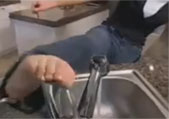
What is obsessive compulsive disorder?
Dr. Oz and Dr. David Tolin explain what OCD (obsessive compulsive disorder) is.
Video courtesy of NBC.

OCD defined: From answers.com - obsessive-compulsive disorder (psychology) A type of anxiety disorder characterized by recurrent, persistent, unwanted, and unpleasant thoughts (obsessions) or repetitive, purposeful, ritualistic behaviors that the person feels driven to perform (compulsions). Abbreviated OCD.
About OCD: by Phillip W. Long, M.D. - Either obsessions or compulsions: Obsessions as defined by: Recurrent and persistent thoughts, impulses, or images that are experienced, at some time during the disturbance, as intrusive and inappropriate and that cause marked anxiety or distress the thoughts, impulses, or images are not simply excessive worries about real-life problems the person attempts to ignore or suppress such thoughts, impulses, or images, or to neutralize them with some other thought or action the person recognizes that the obsessional thoughts, impulses, or images are a product of his or her own mind (not imposed from without as in thought insertion)
Compulsions as defined by (1) and (2):
- Repetitive behaviors (e.g., hand washing, ordering, checking) or mental acts (e.g., praying, counting, repeating words silently) that the person feels driven to perform in response to an obsession, or according to rules that must be applied rigidly
- The behaviors or mental acts are aimed at preventing or reducing distress or preventing some dreaded event or situation; however, these behaviors or mental acts either are not connected in a realistic way with what they are designed to neutralize or prevent or are clearly excessive At some point during the course of the disorder, the person has recognized that the obsessions or compulsions are excessive or unreasonable. Note: This does not apply to children.
The obsessions or compulsions cause marked distress, are time consuming (take more than 1 hour a day), or significantly interfere with the person's normal routine, occupational (or academic) functioning, or usual social activities or relationships. If another Axis I disorder is present, the content of the obsessions or compulsions is not restricted to it (e.g., preoccupation with food in the presence of an Eating Disorder; hair pulling in the presence of Trichotillomania; concern with appearance in the presence of Body Dysmorphic Disorder; preoccupation with drugs in the presence of a Substance Use Disorder; preoccupation with having a serious illness in the presence of Hypochondriasis; preoccupation with sexual urges or fantasies in the presence of a Paraphilia; or guilty ruminations in the presence of Major Depressive Disorder). The disturbance is not due to the direct physiological effects of a substance (e.g., a drug of abuse, a medication) or a general medical condition.
Specify if: With Poor Insight: if, for most of the time during the current episode the person does not recognize that the obsessions and compulsions are excessive or unreasonable.
Dr. Tolin demonstrates how to stop compulsions on The OCD Project.
This is a brilliant explanation of what obsessive compulsive disorder (OCD) is by Dr. Tolin on The OCD Project. He also discusses what works to treat it and why. And explains how OCD gets very tricky with the notorious "Yes, buts" of the obsessive compulsive mind.
For more information on Dr. David Tolin visit drtolin.com For more information on The OCD Project visit ocd.vh1.com Video courtesy of Vh1. Vh1 logo and The OCD Project content are property of © 2010 MTV Networks, © and ™ MTV Networks. All Rights Reserved.
Video courtesy of NBC.
How do you treat OCD?
How do you treat OCD? Medications work for some, exposure with response/ritual prevention (ERP) works for most, and the combination of these two can act as a one-two punch that works for the others.
I would suggest that the most success in the fight against this chemical imbalance in the brain has come from a combination of therapy and ERP. This way, once the sufferer talks about the thoughts that are essentially driving them nuts, they start to realize that they are a bit off base and that their mind has come a bit off track. The exposures eventually help to retrain the brain and start to right the many years of wrongs, in most cases.
There has also been great success in the fight against this disorder via desensitization—mostly with contamination based OCD, or the "C" that stands for cleaning. An example of desensitization would be if someone was afraid of turning off faucets after their done washing their hands, they might find that turning the faucet off with just their pinky would help. Then they could turn the faucet off with their pinky and ring finger a week later, after being successful with just the pinky why not? Then they would gradually expose themselves to the fear and then would overcome it as they realize that nothing bad is happening. And then they would eventually be able to turn the handle of the faucet of like most people normally do.